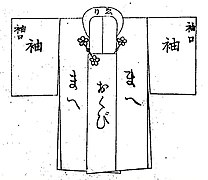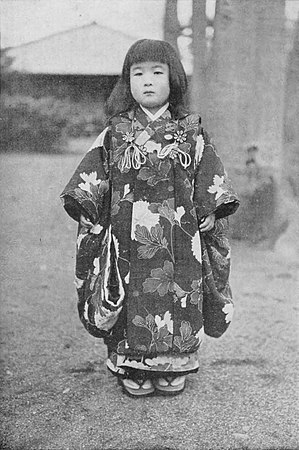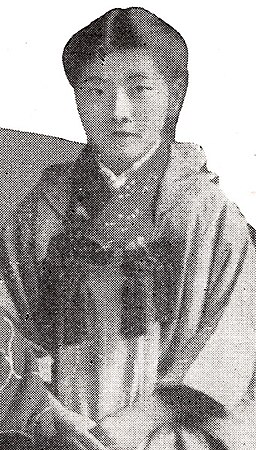Hifu (garment)

Hifu (被風, 被布, 披風) is a kind of jacket traditionally worn over a kimono. Towards the end of the Edo Period (1603–1867), it was worn by men in cultural positions, such as by chajin (tea ceremony masters) and haijin (haiku poets). It later came to be worn by women.[1] Sodenashi hifu are sleeveless and more likely to be worn by children, while sleeved hifu are more often worn by adults. Sleeveless hifu serve as smocks, protecting the clothing underneath, while sleeved hifu are more likely to be worn for warmth. Sleeveless hifu are commonly seen as part of a child's clothing when worn for Shichi-Go-San.
It is the origin of current kimono coat.[clarification needed]
Structure[edit]
-
Open
-
Closed
-
An azuma-coat, tying at the hip, of similar cut[2]
The hifu's shape and use are similar to those of the haori (a wrapped-front kimono coat). Unlike the haori, however, the hifu is a double-breasted coat; the front panels are wide enough to cover the whole chest, and they tie (or button)[3] at the shoulders. Its neckline is square with a flat collar (banryo), not a round collar (marukubi).[1] A hifu may be padded for extra warmth.[4]
Fancy hifu are often made of rinzu (Japanese figured silk satin) and tied with silk braided cords in a chrysanthemum knot. They are worn by young children on the occasion of Shichi-Go-San, as part of an auspicious formal outfit.
Gallery[edit]
-
1912
-
1910s or 1920s
-
A 1920s hifu with ribbon ties.
-
A schoolteacher wearing a hifu with white ties, 1912.
-
Niijima Yae in a hifu
See also[edit]
- Hanten
- Haori
- Happi
- Academic gown, a warm overgarment with a similar historic social role
- List of items traditionally worn in Japan
References[edit]
- ^ a b c Yu, A. C. "Hifu - Japanese Wiki Corpus". www.japanese-wiki-corpus.org. Generated from the Japanese-English Bilingual Corpus of Wikipedia's Kyoto Articles which is translated by the National Institute of Information and Communications Technology (NICT) from Japanese sentences on Wikipedia, used under CC BY-SA
- ^ Inouye, Jukichi (July 2021) [c. 1910s]. Home Life in Tokyo. Digitized. p. 126.
At one time shawls were much in vogue and worn together with the hood; but they have of late fallen out of favour. Their place is taken by "azuma-coats," which are overdresses worn over the kimono. They resemble the latter in form, except that they are looser and have much wider bands which come down to the skirt and dispense with gores altogether. In the latest forms the sleeves are very large; the front is double-breasted with the throat open; and the overlapping parts button at the breast by means of a loop and knot and are tied at the hip with a string. They are made of silk. They are vulgarly known as "rag-concealers," as many women put them on when they go out to hide the shabby dresses underneath.
- ^ "Furusato: Yoko's Hometown, YokoDana Kimono Japan". www.yokodana.com.
- ^ Monson, Christian (25 June 2020). "The History Of Traditional Japanese Clothing". Japanjunky. Retrieved 26 January 2022.
- ^ 被布の名稱及び沿革『裁縫精義. 羽織篇』奈良女子高等師範学校裁縫研究会 編 (東洋図書, 1949)



![An azuma-coat, tying at the hip, of similar cut[2]](http://upload.wikimedia.org/wikipedia/commons/thumb/0/0b/Azuma_coat.png/155px-Azuma_coat.png)




